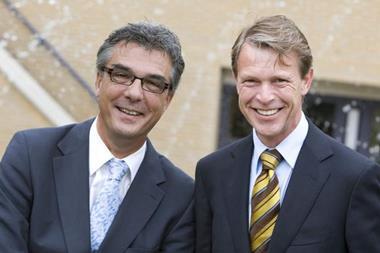S:t Erik Försäkring was the first public sector captive insurance company in Sweden. Based in Stockholm, it provides cover for activities run by the capital city. Nathan Skinner spoke to chief executive Anders Carlsund
Why did the City of Stockholm decide to start its own captive insurance company?
The company began operating more than 20 years ago as a reinsurance company. Nowadays, it is only direct insurance we deal with, and we go out to the international markets to place reinsurance. By having agreements with a number of insurers and reinsurers with good financial strength we can achieve a good spread of risks. During the past year, S:t Erik Försäkring has had agreements with nine large international companies, whereby they insure the City’s buildings and inventory in excess of our retention.
So the local market does not handle our insurance, we go directly to the international reinsurance markets. As we became a very big buyer of insurance in Sweden, it was rather difficult to look to the local market to find solutions. It was a natural thing for us to go to the international market directly. We are big enough to cut out the middleman. Although we were the first in the public sector, big Swedish companies, like Volvo and Ericsson, had already set up insurance captives of their own. We looked at that and thought it was probably a good idea to do the same.
So was it driven by a desire for better rates?
Among the activities run by the City a number of very big companies, like the water and housing authorities are involved, all of whom used to go to the insurers individually. Now they come to me, and I put everything together into a portfolio of risks for the City and I ask the market for a price. S:t Erik Försäkring is one of the largest buyers of insurance in the country. We have an overall insured value of around SEK 250bn (£21bn, €26bn). Packing all the risks together is a very good way to buy insurance because we are more attractive on the market. That’s the idea.
Did your decision to start up a captive mark the beginning of a trend in the public sector?
Yes it did, but the public sector authorities need to be big enough in order to be able to do it themselves. When Stockholm looked at it we did the calculations and it worked in our favour, but the problem with other municipalities in Sweden is that they are too small. However, municipalities are increasingly looking to form captive insurers due to the lack of competition in the Swedish insurance market. Among others, over 20 municipalities in the Stockholm County have joined together in forming their own insurance companies. In this way the municipalities gain direct access to the international reinsurance markets, thus increasing competition. It has opened a new market in Sweden, the captive market, which has been very interesting.
Has the private insurance market in Sweden contracted as a result of the growth in captives?
It is difficult for me to answer that. About half of public sector organisations have captive insurance companies, and most of the big companies on the Swedish stock market have their own captive. So it is a big market in Sweden. Normal insurance companies say it’s not a problem for them because they can provide services for the captives. A normal captive handles around half of the risk of the parent company and the rest goes out to the market. I don’t think it is a big problem.
What are the main risks that you are concerned about at the moment?
If you look at our biggest exposures, number one is our exhibition company, Stockholm International Fairs, number two is Stockholm Globe Arena, and number three is the City Hall.
In Sweden, the expenses caused by fire continue to be high. During 2007 we saw a large number of fire losses, most of them in the City’s schools and most of them caused by arson. The total loss expense was lower than in 2006, SEK 114.1m, of which 106.3m refers to fire, 4.3m to water damage, 1.4m to burglary, 2m to liability claims and 0.1m to other types of claim. The largest loss was a fire in a day-care centre which totalled 28.5m.
For the last ten years the total expenses caused by fire has been some SEK 4bn per year. There is a tendency towards rising expenses for fire. More than 50% of the fires in Sweden are either caused by arson or have an unknown cause. Interestingly the problem was mainly in our schools and pre-schools. We have been working hard to combat this challenge, but it is still a problem in Sweden and other countries too. Our biggest problem is in special schools. The great challenge during 2008 will be to reduce the number of claims within the entire Municipal Group. It is not acceptable that during 2007 schools and day-care centres have been destroyed by fire at a cost of over SEK 73m (SEK 100m in 2006), which has meant that hundreds of children have had to change premises. Arson is a problem for society which we all must come to terms with.
Are you engaged in risk management to mitigate that risk?
We are very much engaged in risk management. Every individual company is responsible for their own risk management; we can’t take responsibility for them. We can help them and stimulate improvement by setting premiums. If you do this then your premium will be better, for example. With your own insurance company you can change the premium if you want to help stimulate improvement.
However, much can be done immediately to reduce the consequences of fire caused by arson. Investments in good detection systems, for example. We are currently installing direct alarms to the fire brigade in our schools. It is a profitable investment to prevent fire and burglary. It is also a question of good will to make sure that our buildings are not damaged, so that the City can maintain the service level it has promised its citizens. It is a social problem and one that we must take care of. During the school holidays in Sweden we take extra care to make sure that our children have things to do.
Have you initiated any other strategies?
I work very much with risk management. Stockholm’s Chief Executive Office has established a risk management council. I sit on this council. In this way, the City has created a forum for exchange of experiences and pointed out that risk management should be a natural process within the Municipal Group of Stockholm. The council has about four or five meetings each year and makes a joint effort to create safer and more secure operations within the City of Stockholm. We discuss plans to deal with major events, or long term problems, and how to implement risk management processes. We help to identify risk management processes and the type of claims that could happen as well as what can be done to reduce the likelihood of claims. We report our findings every year. What to do in the event of a major flood could be a question for the council. It has never happened but it could happen in the future because the City of Stockholm is very close to sea level. Pandemics are also something that could be a question for the council, but we have not addressed that yet.
Are you focused on any risks as a result of weather related events?
We don’t have much of a problem with weather related catastrophes in Stockholm. The south part of Sweden has many storms. But it has never been a major problem here in the City.
What benefits has the City of Stockholm reaped as a result of setting up its own captive?
One thing is that it gives us a very good understanding of our own risk, because we have data for all of the claims that have happened over the past 20 years. With our own insurance company we have all the statistics about when our customers claim. A private insurer might not release those statistics, because they belong to the insurer not the customer. That was a very big problem for us, because as a big buyer of insurance we needed to have access to our own statistics. So more transparency is one major benefit. We can also handle claims much faster than a private insurer. Another benefit is that the capital always remains within our organisation. Our customers in the City pay premium to me, all of that premium is handled by our internal bank so it is managed and never leaves the company. That is very important for us. It is much slower going around in the insurance system, where you pay premiums until you need the money for paying a claim. You could wait 10 years before you have a big claim, but if you retain the money yourself it is a better way to handle the cash flow.
Are there any downsides?
One limiting factor could be that a company looking to set up a captive must be very big because they need to be able to compete and have the knowledge to run an insurance company. It is no easy task to run an insurance company even if it’s a small operation. It might be difficult to find the right leadership and it could be expensive.
What are some of the issues that are affecting risk managers across Sweden?
Most of the risk managers in Sweden at the moment are members of the Swedish Risk Management Association (SWERMA). The big issue that most of them are currently talking about is enterprise risk management (ERM). It is a big challenge to understand and implement this methodology.
Are those processes not very well established in Sweden?
In the big companies they are fairly well established, but many risk managers in Sweden are still working on implementing the process.
Finally, has the global credit crunch had much of an impact in Sweden?
In Sweden we haven’t seen much of an impact from it. We had our banking crisis in 1992. Perhaps we have learned something from that.
Postscript
Nathan Skinner is senior reporter, StrategicRISK



















No comments yet